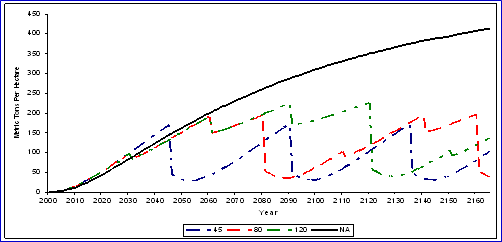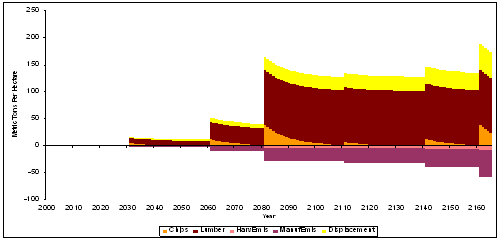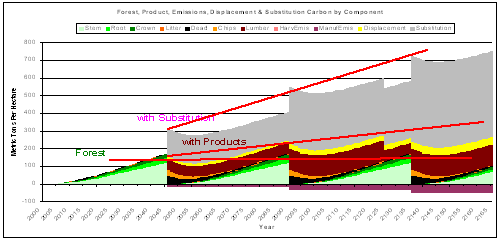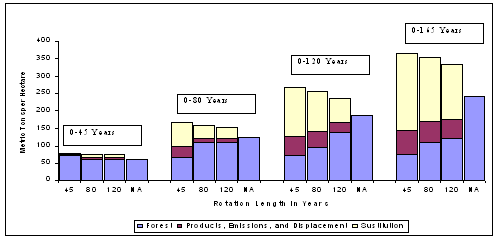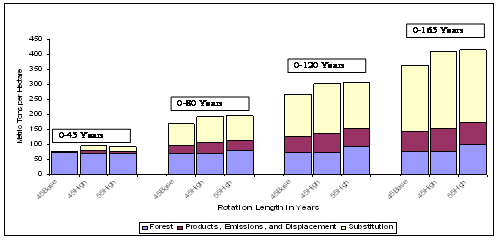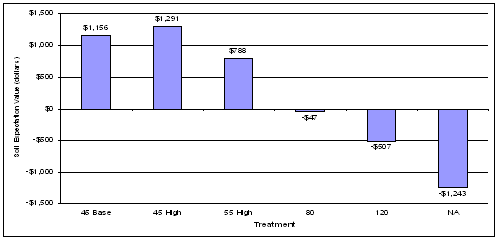|
Revised May, 2004
|
Save or Print a PDF
copy of Fact Sheet #17
Bruce Lippke, John Perez-Garcia and Jeffrey Comnick
Some suggest that longer rotations store more carbon
while also being complementary to biodiversity and endangered
species.
Others suggest that more intensive management can store
more carbon at lower cost. Some say the carbon stored in
products
is not important since it deteriorates over time releasing
carbon emissions. Others say the buildup of wood products
is a major source of increasing carbon pools. Some say
that preserving old growth stores more carbon than manufacturing
products. Others say that the carbon in the forests would
neither increase nor decrease over the long term if we
avoided
deforestation and land use conversion. In spite of differences
in approach, reducing carbon emissions has become an international
commitment and carbon trading or carbon credit markets
are developing. So what do we know about the role of northwestern
forests on carbon? |
|
On the question of the forests role in storing carbon and the impact
of forest management on carbon storage, a consortium of 14 research
institutions across the US (mostly universities) have been looking
at this question for several years. The Consortium for Research on
Renewable Industrial Materials (CORRIM), a not for profit university
lead research group, developed a research plan in 1998 to study the
complete environmental performance of wood by developing a life cycle
inventory (LCI) data base of all inputs and outputs from forest regeneration,
through harvest, processing, construction, building use and final
disposal. They completed a review draft of their final report on
forests in the PNW and SE in January of 2004. This revised Fact Sheet
summarizes the impacts of forests and forest products on carbon under
several management strategies as reported in the CORRIM Phase I Final
Report (draft).
The simplest example often cited is that you can store more carbon
in the forest on longer rotations or with no harvest at all. It is
true that extending the rotation age from 50 to 100 years in the
PNW will more than double the inventory of wood and carbon stored
in the forest. Extending the age even further will increase the carbon
stored somewhat more but eventually, due to natural the natural aging
process and disturbances such as windstorms, fire, and disease the
volume of timber and carbon stored will decrease, followed by new
growth and renewal. Looked out over the long term across these disturbances
and with no harvesting, the long term average of carbon stored on
a fixed acreage of forestland will not likely change very much although
the increase in fossil fuel emissions and global warming may alter
that stability.
However, this is just the beginning of the carbon storage accounting
if any products are removed from the forest. While short-lived products
such as paper may enter the waste stream quickly and decompose, long
lived products including housing construction continue to grow over
time as more houses are built and the carbon stored in houses lasts
longer than the rotation age, thereby accumulating carbon storage
from rotation to rotation. The housing stock continues to increase
and therefore the carbon stored in housing is increasing. The carbon
stored in forests (stem, root, crown, litter, and dead or dieing
carbon pools) under rotations intervals of 45 years, 80 (with two
thinnings), and 120 (with three thinnings), and no harvest or disturbance
are shown in figure 1. Simulations show that longer rotations do
store more carbon in the forest with the no harvest (or disturbance)
scenario producing the most. Empirical data shows little if any increase
in carbon stored in NW forests beyond 120 years.
The carbon in short-lived product pools removed from the forest decomposes
rapidly resulting in carbon emissions while those in long-lived products
decompose slowly with some residual build-up in storage from rotation
to rotation. The carbon stored in products is illustrated in Figure
2 under an 80 year rotation showing successively more product in
the first two thinnings prior to the harvest. The chart also displays
the emissions from the logging and manufacturing as negative pools,
the rapid decomposition of short lived products such as chips, and
the carbon in lumber products lasting 80 years, the expected life
of a house.

|
| Figure 1. Carbon in forest pools for different rotations |
|
|
| Figure 2. Carbon in products, energy displacement
and processing emissions |

When the short lived products are used as a biomass source for
producing energy (co-generation), net electrical energy is added
to the electrical grid. While a low valued use of wood and probably
not the best way to increase carbon storage, using the wood as
a fuel (thereby substituting for fossil fuels), will increase carbon
storage over time without the decomposition associated with short
lived products. The figure illustrates displacement of fossil fuels
when low valued co-products other than chips for paper are used
as a biofuel.
Figure 3 shows the carbon stored in the forest and both short and
long lived product pools along with the displacement of fossil
fuels as a positive pool and the energy for processing as a negative
pool for an 80 year rotation. It also shows a positive carbon pool
for substitution as the long lived products are substituted for
concrete framed buildings. Note that the carbon in the forest is
stable across rotations, and by adding the carbon in products there
is a modest increase in carbon stored but by including the substitution
for more energy intensive products such as steel or concrete there
is a much more positive trend in stored carbon.
Long rotations or no harvest have a very counterproductive impact
on the product and substitution pools since the contribution from
products occurs so much later in time. Figure 4 summarizes the
carbon account averages for intervals of 0-45, 0-80, 0-120 and
0-165 for each of the rotation scenarios and the no action scenario.
In the first 45 year, since there is no harvest, there is little
difference between the alternative scenarios. For the 0-80 year
interval, the 45 year rotation harvest results in substantial product
substitution resulting in more carbon stored than the other scenarios.
For the 120 year interval, a harvest has also occurred on the 80
year rotation and a heavy thin on the 120 year rotation. Finally
by 165 years all scenarios have included a harvest. The total carbon
stored is for each interval decreasing with rotation age even though
the carbon in the forest and even in the forest and products is
increasing with rotation age.
|
|
Figure 3. Carbon in the forest and
product pools with concrete substitution for the
45 year rotation |
|
|
Figure 4. Average annual
carbon in forest, product and concrete substitution
pools for different rotations. |

Since the greatest carbon storage occurs with the shortest rotation
it should be obvious that more intensive management with a short
rotation should be even better. Figure 5 shows the carbon stored
in the base case with a 45 year rotation and a more intensive management
case including fertilization and a commercial thinning on the same
rotation. As a second case, the rotation was extended 10 years
to see if the response time after the thinning would produce increased
storage. There is a significant increase in carbon stored from
the intensive management but very little gain by also increasing
the rotation age another ten years.
Drawing the boundary conditions for the analysis around a forest
is only correct if there is no harvest, in which case over the
long term the forest stores a substantial amount of carbon but
it is neither increasing nor decreasing when looking across disturbance
cycles. In that sense, it plays no role in the equation for mitigation
in global warming and how to reduce carbon emissions. Changes in
management which includes conversion to forestry but especially
producing more products as soon as possible to replace energy intensive
substitutes has the largest impact. The economic returns do not
change this finding. Figure 6 displays the Soil Expectation Value
(SEV) with a 5% (real) interest rate. SEV is the return to the
land from perpetual rotations. While there is a small increase
in carbon for the intensive management 55 year rotation over the
shorter rotation, the cost penalty from the longer rotation is
already substantial. The economic returns to intensive management
are not large and might even be negative with low prices for small
logs. Nevertheless, any small incentive related to the increased
carbon stored would logically support a significant increase in
management intensity as it reduces the risk of making such an investment.
The 80 and 120 year rotations have fallen below the 5% discount
target with no increased carbon storage as a consequence, unless
substitution is ignored.
|
|
| Figure 5. Average carbon
in forest, product and concrete substitution for different
management intensities. |
|
|
| Figure 6. Soil Expectation
Value for different rotations and management intensities. |
The carbon in the forest is only useful for increasing carbon
storage if land not in forestry is converted to forestry (afforestation),
a one time increase in storage, or if periodic harvests convert
the trees to long lived products producing an increasing pool of
product storage in buildings. More intensive management that increases
volume growth producing more long-lived products also increases
carbon storage. In the PNW, that means intensive management on
45-50 year rotations for average site productivity is probably
optimal. When carbon credits include the effects of substitution,
a higher price for carbon in the short term would likely reduce
rather than increase the rotation age. If substitution is ignored
carbon credits would be likely to motivate longer rotations which
may well be counter productive to the objectives of reduced carbon
emissions.
References:
(1) Manriquez, C. 2002. Carbon sequestration in the Pacific Northwest:
a model. Master's thesis. University of Washington, Seattle, Washington,
USA.
(2) Bowyer, J. et al. 2002. Life Cycle Environmental Performance
of Renewable Industrial Materials: CORRIM Phase I Interim Research
Report. CORRIM Inc. (in care of College of Forest Resources, University
of Washington)

|








